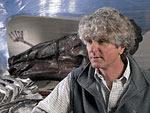
Distinguished Professor and Curator Emeritus
Email: kpadian@berkeley.edu
Phone:
Research Description
Professor Padian retired in 2020 and he is no longer taking or advising students. But he is open to conversation, consultation, and collaboration.
My work falls into five general areas: (1) Origin of major evolutionary adaptations. Through a synthesis of phylogenetic, functional, and comparative morphological evidence, I try to assemble the best-supported evolutionary sequences available and to reconstruct the steps by which major adaptations, particularly vertebrate flight (pterosaurs, birds, and bats), arise. (2) The beginning of the "Age of Dinosaurs." Although I work generally on Mesozoic vertebrate paleontology, I am most interested in the changes in the terrestrial vertebrate fauna that took place around the Triassic-Jurassic boundary. (3) Systematics, functional morphology, and flight of pterosaurs. Pterosaurs, the first vertebrates to gain powered flight, provide many interesting keys to the evolution of posture, locomotion, homeothemy, and vertebrate adaptation in the early Mesozoic Era. (4) Histology and constructional morphology of the bones of extinct reptiles. Comparative bone histology in a phylogenetic series of taxa and some ontogenetic series can provide the best picture of age, growth, and metabolism, and engineering design helps to understand functional adaptations of bone. Our histology work is in conjunction with other researchers in California, Montana, and France. (5) Species recognition, sexual selection, and related processes in living and extinct vertebrates. “Bizarre structures” in dinosaurs and other vertebrates often are assigned a “default” origin in sexual selection, but thus far they show no sexual dimorphism, which is a requirement for sexual selection (following Darwin). We investigate how species recognition, mate recognition, and other processes may have played roles in the evolution of these structures.
We also have a long-standing and strong interest in public education, the representation of science, the history of science, and a strong representation of evolutionary science in curricula.
For more information please visit our lab page: http://ib.berkeley.edu/labs/padian/
Selected Publications
Padian, K. 2022. Why tyrannosaurid forelimbs were so short: An integrative hypothesis. Acta Palaeontologica Polonica 67 (1): 63–76.
Padian, K. and M. A. Brown (eds.). 2021. The Late Cretaceous pterosaur Quetzalcoatlus Lawson 1975 (Pterodactyloidea: Azhdarchoidea). Memoirs of the Society of Vertebrate Paleontology 19: 1-256. [Journal of Vertebrate Paleontology 41 (2, suppl.): 1-256.]
Buffrenil, V. de, A. de Ricqles, L. Zylberberg, and K. Padian (eds.). 2021. Vertebrate Skeletal Histology and Paleohistology. CRC Press, Boca Raton, FL.
Padian, K. and E.-T. Lamm (eds.). 2013. Bone Histology of Fossil Tetrapods: Issues, methods, and databases. University of California Press, Berkeley.
Padian, K., and H.N. Woodward. 2021. Archosauromorpha: Avemetatarsalia – Dinosauria and their Relatives. Pp. 511-549 in Buffrenil, V. de, A. de Ricqles, L. Zylberberg, and K. Padian (eds.), Vertebrate Skeletal Histology and Paleohistology. CRC Press, Boca Raton, FL.
Padian, K., J.R. Cunningham, W.A. Langston, and J. Conway. 2021. Functional morphology of Quetzalcoatlus (Pterosauria: Azhdarchoidea). Memoirs of the Society of Vertebrate Paleontology 19: 218-251. [Journal of Vertebrate Paleontology 41 (2, suppl.): 218-251.]
Prothero, D.R., Domning, D., Fordyce, R.E., Foss, S., Janis, C., Lucas, S., Marriott, K. L., Metais, G., Naish, D., Padian, K., Rössner, G., Solounias, N., Spaulding, M., Stucky, R.M., Theodor, J., and Uhen, M. 2021. On the unnecessary and misleading taxon “Cetartiodactyla.” Journal of Mammalian Evolution. https://doi.org/10.1007/s10914-021-09572-7. (5 pp.)
Andres, B., and K. Padian. 2020. Pterosauromorpha, Pterosauria, Pterodactyloidae. Pp. 1195-1199, 1201-1204, 1205-1207 in Phylonyms: A Companion to the PhyloCode (K. de Queiroz, P. D. Cantino, and J. A. Gauthier, eds.). CRC Press, Boca Raton, FL.
Padian, K., and de Ricqlès, A. 2020. Inferring the physiological regimes of extinct vertebrates: methods, limits and framework. Phil. Trans. R. Soc. B 375: 20190147.
Padian, K. 2018. Measuring and comparing extinction events: Reconsidering diversity crises and concepts. Integrative and Comparative Biology.
Padian, K. 2018. Narrative and “anti-narrative” in science: How scientists tell stories, and don’t. Integrative and Comparative Biology.
Manafzadeh, A.R. and K. Padian. 2018. ROM mapping of ligamentous constraints on avian hip mobility: implications for extinct ornithodirans. Proc. R. Soc. B 285: 20180727.
Padian, K. 2017. Structure and evolution of the ankle bones in pterosaurs and other ornithodirans. Journal of Vertebrate Paleontology. DOI: 10.1080/02724634.2017.1364651 (14 pp).
Padian, K. 2008. Were pterosaur ancestors bipedal or quadrupedal?: Morphometric, functional, and phylogenetic considerations. Zitteliana 28B: 21-28.
Padian, K., Cheng Li, and J. Pchelnikova. 2010. The trackmaker of Apatopus: early diversification of archosaur stance and gait. Palaeontology 53: 175-189.
Padian, K. and J.R. Horner. 2011. The evolution of “bizarre structures” in dinosaurs: function, sexual selection, social selection, or species recognition? Journal of Zoology 283: 3-17.
Padian, K. 2013. The problem of dinosaur origins: integrating three approaches to the rise of Dinosauria. Earth and Environmental Science Transactions of the Royal Society of Edinburgh, 103: 423-442 (for 2012).
Padian, K. and E.-T. Lamm (eds.). 2013. Bone Histology of Fossil Tetrapods: Issues, methods, and databases. University of California Press, Berkeley.
Padian, K., and J.R. Horner. 2014. The species recognition hypothesis explains exaggerated structures in non-avialan dinosaurs better than sexual selection does. C. R. Palevol 13: 97-107.
Padian, K. and H.-D. Sues. 2015. The Age of Transformation: The Triassic Period and the rise of extant land vertebrate fauna. In Shubin, N.H., Dial, K.P., and Brainerd, E. (eds.), Great Transformations: Major Events in the History of Vertebrate Life, pp. 351-374. University of Chicago Press.
Padian, K., Werning, S., & Horner, J.R. 2015. A hypothesis of differential secondary bone formation in dinosaurs. Comptes Rendus Palevol.
Padian, K. 2013. Correcting some common misrepresentations of evolution in textbooks and the media. Evolution Education and Outreach 6: 1-13.
Padian, K., and N. Matzke. 2009. Darwin, Dover, “Intelligent Design,” and textbooks. Biochemical Journal 417: 29-42.
Padian, K. 2009. Ten myths about Charles Darwin. BioScience 59: 800-804.